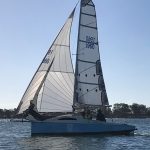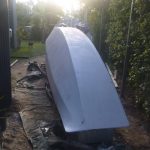This is a comparison of 2 x 550 monohulls designed by myself to two totally different specifications built in the same year.
About 3 years ago I was approached by a mate of mine, Mick Unwin, of Brisbane to design him an up-dated 550 designed sports boat. Mick had built an 8-metre cruiser/racer design of mine “Fuzzy logic” previously but with a young family resulting in limited time and budgetary constraints he was after something smaller and less demanding. After discussions I drew up a development of my Spider 550 design without the restrictions placed on a production boat. His hull shape features a single chine above the waterline blended in to a high stability hull form. Not long after the design was settled and Mick began building, I ripped my Achilles tendon in half and ended up on my back not walking for 3 months. During my recuperation it became apparent I was never going to hike out or put my feet under toe straps again, I was lucky to be walking. At the time I had been sailing a 580 trimaran I had designed and built but walking on trampolines was not going to be an option so it was time to look at another monohull. Having most recently finished the design for Mick that was a logical starting point but one of the benefits of designing and building for yourself is there are no restrictions or preconceptions other than the budget and the fact I could not hike out so it had to be a “sit-in” boat. Having always admired the open designs and the open 40’s in particular I have watched the development of the scow designs and so settled on a “scow with a bow” thus “MissUnderstood” was conceived. I wanted her to have an almost retro-style whilst Mick wanted “Fuzzy Logic’ to have a contemporary look.
Mick had settled on foam and glass as the construction technique for his new “Fuzzy logic” with a modest but strong laminate using double bias woven cloth set in epoxy resin with a tailored laminate specification built over temporary MDF building jig. Now I was to build in the back yard which is always challenging and more so with my narrow side access so I decided to build mine in two halves, down the centreline as done with several multihull designs. The scow hull form with vertical topsides and flat bottom panels made this a viable option so I chose to build her in fibreglass sheathed sheet plywood. She was never going to be the lightest boat out there but it was a practical method built over permanent frames with no stringers, chine logs or gunwales, she was effectively stitch and tape. When eventually fitted together I was relieved to find the two sides were within 3mm, not bad for being effectively built on a beach under a tarp.
It would be difficult to find two more different yachts of the same length. Mick had gone for the now-predominant vertical lifting board with a 120 kg bulb whilst I wanted to be able to sail mine up the beach. I’m also of the opinion that for ¾ of most sailing the bulb provides little contribution to stability and is effectively drag until you are sailing up wind in 15+ knots. In hindsight a vertical lift bulb-less board would have been easier and more efficient but I solved the drag of the long centreboard slot with a plug fitted once the board is lowered. MissUnderstood relies on form stability which she has in bucket-loads whilst Fuzzy logic relies on crew weight and the bulb. To try and negate some of the weight difference in the construction the board in MissUnderstrood weighs in at about 80kgs compared to the 125 kgs of Mick’s.
The cockpits in both boats are huge, MissUnderstood’s is 2.70 metres long from the companionway bulkhead to the transom. To maximize the waterline sailing length I extended the hull in the form of a boarding platform out between the rudders effectively making the hull the same length in-line with the back edge of the rudders. Both boats are fitted with twin rudders as is standard for my designs with Mick choosing twin tillers while mine has a single tiller with cables and a tie bar. This is currently being modified with the cassetted swing-up rudders being replaced with shaft rudders which will swing up as per open 40’s & 60’s so that I can fill in the stern cut-outs currently necessary for the blades set up in the cassettes. Mick has fitted the gudgeons off-set on the side of the rudder boxes rather than on the front. My reasoning being to enable his vertical lifting blades to have lead in front of the pivot points, balancing them up. This has been done on other designs and works well.
With the rigs, as previously mentioned, Mick had an existing skiff rig with carbon mast set up as is now common with no backstays as per the 16 and 18 footers. The original mainsail was cut down with a maxi fat top head. We managed to get pretty close to the original design concept and that of the Spider 550. With MissUnderstood again I went in the opposite direction. I needed a short but efficient rig to get the centre of effort as low as possible to accommodate the lack of bulb. Having developed a rig for my trimaran I was impressed with its efficiency so went that way. Mine was an aluminium wing mast out of a Tornado set up to rotate with no proper spreaders and a single set of diamonds. The mainsail is basically rectangular with little topmast and no backstays. The mainsail luff measurement is about a metre less than Fuzzy Logic’s. As I wanted to be able to sail mine single handed, I decided on a self-tacking headsail but to ensure I had a similar sail area required some lateral thinking. MissUnderstood is set up with two headsails. The no.2 is set at the stem whilst the no.1 the forestay is moved out approximately 500mm on to the bow sprit. This has to be done on the beach but is quick and easy and both headsails remain self-tacking. As I’m maturing with age and am not quite as mobile as I once was, I have gone with a furling code zero which is truly a wonderous thing. I have a gennaker for those light air runs but seldom use it.
When all done both Fuzzy logic and MissUnderstood were run over weigh bridges. Fuzzy is 80kgs lighter and certainly faster having cleaned up her division in her first regatta at the Magnetic island race week but MissUnderstood is still warming up and for an older bloke’s sit-in boat she performs admirably.





